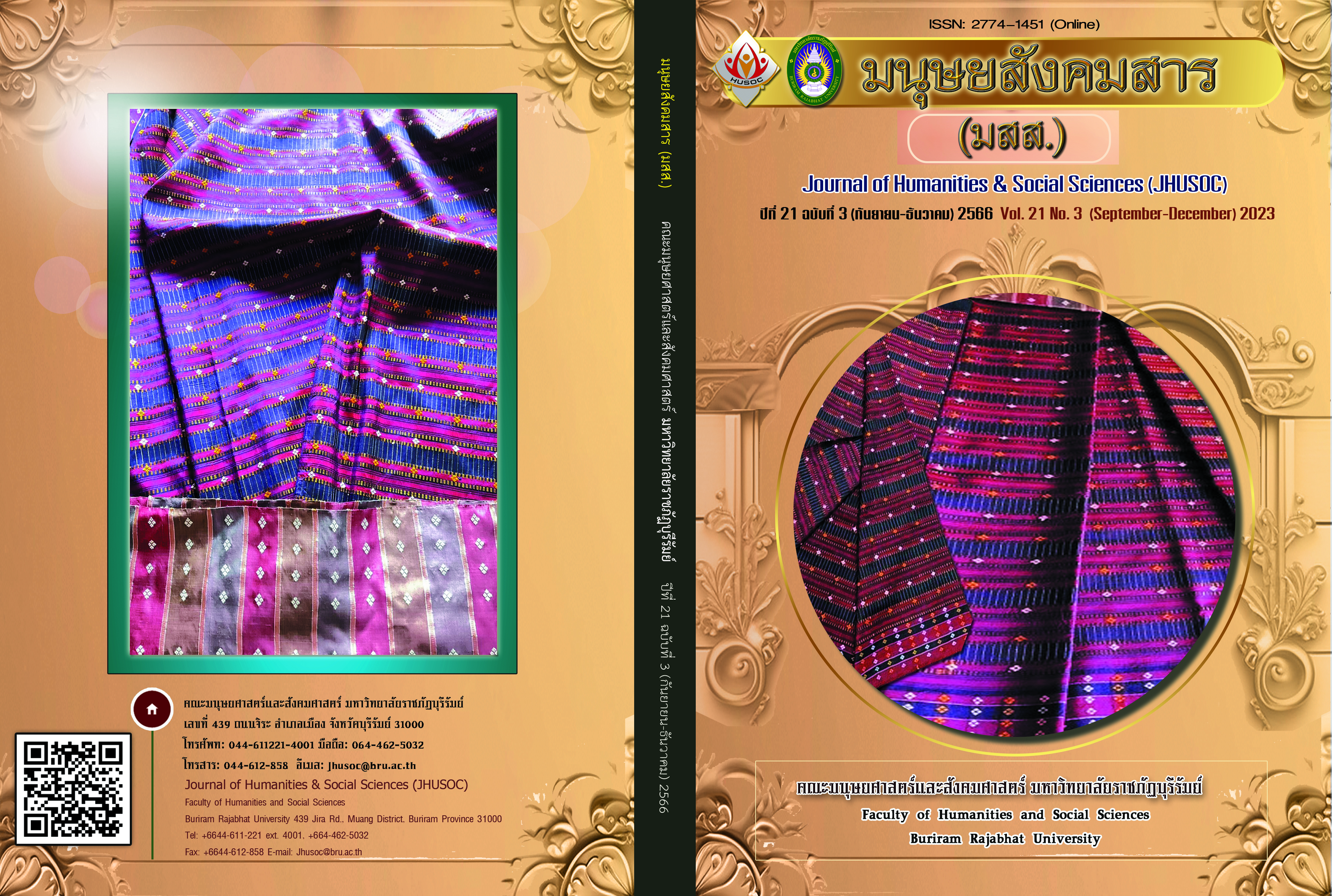The Study of Aesthetic Features Interpretation and Cultural Identity of Baiku Yao Dress Patterns
Main Article Content
บทคัดย่อ
The objective of this research is to design the Baiku Yao Dress Culture Learning Center in Huaili Village and to select 6 interviewees using a heterogeneous sampling method. The majority of them have been dressed in Baikuyao national costumes for more than three months and can provide the interviewer with the necessary information. Semi-structured interviews, literature analysis, and participant observation were all used in this study. Thematic analysis was used to examine the data. The national memory of Baiku Yao created the aesthetic characteristics of this ethnic group during the formation of Baiku Yao dress art; the national memory of Baiku Yao is embodied in the aesthetic characteristics of costumes aesthetic feeling, which explains the cultural identity of Baiku Yao dress. The findings reveal the following four scenarios: First, a look at the historical development of Baiku Yao dress patterns. The aesthetic composition and cultural significance of Baiku Yao dress patterns are discussed in the second part. Third, the identification of Baiku Yao dress patterns and cultural changes. Fourth, the "Huaili Village Cultural Learning Center" capitalizes on the ability of Huaili Village residents to inherit active communication community culture through education, training, and exhibitions, and gives learners full play.
Article Details

อนุญาตภายใต้เงื่อนไข Creative Commons Attribution-NonCommercial 4.0 International License.
เนื้อหาและข้อมูลในบทความที่ลงตีพิมพ์ในวารสารทดสอบระบบ ThaiJo2 ถือเป็นข้อคิดเห็นและความรับผิดชอบของผู้เขียนบทความโดยตรงซึ่งกองบรรณาธิการวารสาร ไม่จำเป็นต้องเห็นด้วย หรือร่วมรับผิดชอบใดๆ
บทความ ข้อมูล เนื้อหา รูปภาพ ฯลฯ ที่ได้รับการตีพิมพ์ในวารสารทดสอบระบบ ThaiJo2 ถือเป็นลิขสิทธิ์ของวารสารทดสอบระบบ ThaiJo2 หากบุคคลหรือหน่วยงานใดต้องการนำทั้งหมดหรือส่วนหนึ่งส่วนใดไปเผยแพร่ต่อหรือเพื่อกระทำการใดๆ จะต้องได้รับอนุญาตเป็นลายลักอักษรจากวารสารทดสอบระบบ ThaiJo2 ก่อนเท่านั้น
เอกสารอ้างอิง
Appadurai, A. (1996). Modernity at large: Cultural dimensions of globalization, Saint Paul. University of Minnesota Press.
Blake, J. (2008). Unesco’s 2003 convention on intangible cultural heritage: The implications of community involvement in “safeguarding”, In L. Smith & N. Akagawa (Ed.) Intangible heritage, 45-50. Routledge.
Durkheim, E. (2011). The Basic Forms of Religious Life (D. Kui & Z. Ji, Trans.). Commercial Press, 492-494.
Gombrich, E. H. (2006). The story of art. Phaidon.
Gauntlett, D. (2011). Making is connecting: The social meaning of creativity, from DIY and knitting to YouTube and web 2.0. Polity Press.
Ingold, T. (2013). Making: Anthropology, Archaeology, Art and Archi tecture. Routledge.
Jefferies, J. K. (2011). Loving attention: An outburst of craft on contemporary art. In M. E. Buzek (Ed.) Extra/ordinary: Craft and contemporary. Duke University Press, 222-242.
Jia, J. S., & Jia, Y. Z. (2014). Cultural interpretation of Baiku Yao women's dress pattern modelling. Beauty and Times, (12), 74-79. http://doi:10.3969/j.issn.1003-2592(s).2014.12.025
Luan, L. W. (2014). Research on Baiku Yao clothing pattern [Master's thesis]. Guangxi University of Arts.
He, M. (2009). The field of vision of artistic anthropology. Journal of Guangxi University for Nationalities (Philosophy and Social Science Edition), 31(1), 6-14. https://www.cnki.com.cn/Article/CJFDTotal-GXZS200901005.htm
Ma, Z. Y., & Liu, Y. Y. (2020). Study on the protection and development path of rural Revitalisation and traditional craft non-heritage. Cultural Heritage, (2),19-29. https://kns.cnki.net/KCMS/detail/detail.aspx?dbcode=CJFD&file-name=WHYA202002003
Muggleton, D. (2000). Inside subculture: The postmodern meaning of style. Berg.
Price, L. (2015). Knitting and the city. Geography Compass, 9(2), 81-95. http://doi:10.1111/gec3.12181
Connerton, P. (2000). How Society Remembers. Shanghai: Shanghai Translation Publishing House.
UNESCO. (2018). Living heritage in the cultural sector: Convention for the safeguarding of the intangible cultural heritage. https://ich.unesco.org/doc/src/2003-convention-basic-texts-2018-version-CH.pdf


